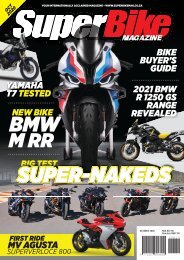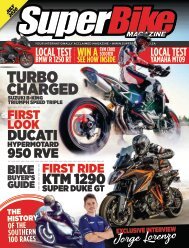SuperBike Magazine June 2020
Lockdown has slowed down our ability to test motorcycles for you. However, we have had a recent gap to be able to get leg over a few. Enjoy.
Lockdown has slowed down our ability to test motorcycles for you. However, we have had a recent gap to be able to get leg over a few. Enjoy.
Create successful ePaper yourself
Turn your PDF publications into a flip-book with our unique Google optimized e-Paper software.
90 YAMAHA R6
Supersports models had
never looked this good,
revved with such excitability
or handled so sweetly
later prove to be exaggerated). This mini R1
had 16 instead of 20 valves but followed the
bigger bike’s layout of stacked six-speed
gearbox, plus one-piece barrels and crankcase
that added rigidity to the twin-spar
aluminium frame. A ram-air system provided
12 of those 120 horses.
Yamaha billed the R6 as a no-compromise
sportster that delivered an extreme
riding experience, and two
days on road and track on the
launch in Australia (remember
when Yamaha had new
sportsbike models to excite
us?) confirmed the firm wasn’t
joking. The R6 was a peaky
little critter that thrived on
being revved to its 15,500rpm
redline.
On the right road and,
better still, on the Phillip Island track, it was
fantastic. The Yam howled out of bends at
an amazing rate for a 600, its digital speedo
showing 165mph with more to come on the
Island’s main straight. Its corner speed was
mighty high, too, thanks to the rigid chassis
“It was
the first
production
bike to claim
200bhp per
litre”
complete with excellent suspension plus
fat sticky radial rubber. And the ferocious,
R1-derived front brake made the lighter-still
R6 arguably the world’s hardest-stopping
bike.
But funnily enough I don’t recall the
launch with quite the warm glow that I
might expect of such a quick bike at such a
glamorous location. Partly, that was due to
the damp and blustery weather,
and to my disappointment
at flying halfway round the
world to find the Great Ocean
Road busier and more heavily
policed than the A47 to Great
Yarmouth. But the R6’s supremely
focused nature played
its part too.
On track or clear road, the
R6 was brilliant, its agility and
sheer speed making for an exhilarating ride.
Throw in some town stuff or main road traffic,
though, and the Yamaha’s peakiness was
a pain. The motor pulled smoothly from low
down but didn’t really wake up till 7,000rpm,
so overtaking often required a couple of
down-changes.
What a buzz
Still, such drawbacks were largely lost amid
the excitement about the bike’s performance.
And fortunately for Yamaha, they’d
guessed correctly that the typical middleweight
sportsbike buyer wouldn’t be fussed
about its failings either. The R6 tonked all
opposition in 1999’s track-based group tests,
sold in big numbers, and took German hardman
Jörg Teuchert to the following year’s
Supersport world championship. The T-shirt
is still racing in Germany and the R6 is still
the supersport weapon of choice…
The R6’s success meant that rival 600s
got racier to challenge it, before in 2006
Yamaha topped the lot with the radical,
third-generation R6, complete with ride-bywire,
shorter-stroke motor and still higher
redline (though the 17,500rpm claim was
nonsense). By then, designer Miwa-san had
created the exotic YZF-R7, then disappeared
from view, possibly to the golf course. His
original YZF-R6 had set the course of middleweight
sportsbike development for more
than a decade.









